Buybacks are back, alright!
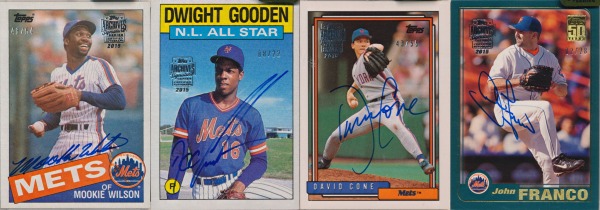 It was a dismal year for Topps Archives, so the announcement of another Archives product at the end of the year was a bit confusing. Would this be a second helping? A non-card product like those Tristar autographed 8x10s? Or something completely different? As it turned out, 2015 Topps Archives Signature Series was the second coming of 2004 Topps Originals and brought with it everything good and bad about that release.
It was a dismal year for Topps Archives, so the announcement of another Archives product at the end of the year was a bit confusing. Would this be a second helping? A non-card product like those Tristar autographed 8x10s? Or something completely different? As it turned out, 2015 Topps Archives Signature Series was the second coming of 2004 Topps Originals and brought with it everything good and bad about that release.
2004 was the height of the retired player autograph boom. In addition to the usual retired player products that were all the rage back then, buyback autographs took center stage with 2004 Topps Originals and 2004 Donruss Timelines. All four (yes, four, such a foreign concept today…) licensed manufacturers had done buybacks previously (though Fleer didn’t get the autograph part and just slapped handwritten serial numbers on some old cards and stuck them into packs), but these products merged the concept with the one-hit-per-pack insertion method. The end result was a pack that, for about $50, would yield a $5 autograph from a minor ’80s star on a card that was far from pack fresh.
Archives Signature Series takes that model and, um, does the exact same thing. There are some notable changes though. First, cards are packed in magnetic holders instead of cheap snapdowns. Second, players who were active in 2004 and have since retired are now included. And third, the choice of cards is more like Donruss Timelines with all sorts of oddballs in the mix, many as 1/1s. And that’s really all that’s changed in 11 years.
Card Design
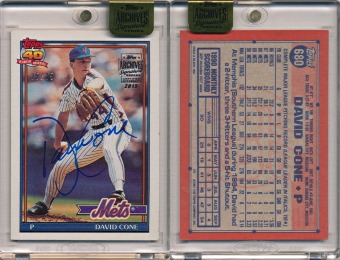 Since this is an all-buyback product, there is no design associated with the cards themselves. All cards feature a silver “2015 Topps Archives Signature Series Certified Autograph” foil stamp and a silver stamped serial number (all cards are numbered to between 1 and 99). Cards are sealed inside a BCW magnetic holder with a gold “Topps Archives Signature Series” sticker. Frustratingly, BCW can’t seem to keep their magnets’ poles pointing the same way, so stacking these can be problematic.
Since this is an all-buyback product, there is no design associated with the cards themselves. All cards feature a silver “2015 Topps Archives Signature Series Certified Autograph” foil stamp and a silver stamped serial number (all cards are numbered to between 1 and 99). Cards are sealed inside a BCW magnetic holder with a gold “Topps Archives Signature Series” sticker. Frustratingly, BCW can’t seem to keep their magnets’ poles pointing the same way, so stacking these can be problematic.
I’m not a big fan of encased cards. For rare or valuable cards, sure, slab them to preserve them. Not my thing, but it makes sense. But these cards? Some of them are barely worth more than the magnetic holder. Most of the rest are worth less than $20 and are already in rough shape. What’s the point of protecting them with a big case? The holders take up a lot of space and require protection themselves because they essentially become part of the card – a point that is lost on most sellers. Many of these came dropped straight into a bubble mailer, some had tape directly applied to the case, and one was bizarrely taped between two abrasive pieces of plywood. Protecting these things is an exercise in futility.
As for the cards themselves, they come from just about anything ever produced by Topps and Bowman, plus a few other products. Everything is fair game – base cards, subsets, inserts, parallels, oddballs, you name it. Autographs (obviously) and memorabilia cards or other thick or oversized cards are not used, though some older cards are shipped in toploaders instead of magnetic holders because of their size. If it’s a standard size card featuring a baseball player on the checklist, it could be out there.
Mets Selection
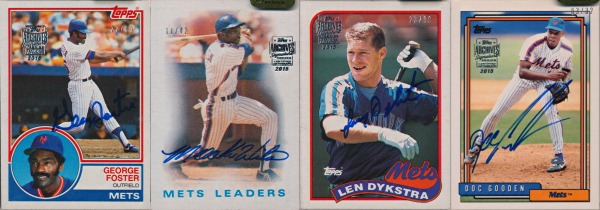 Speaking of the checklist, there is no comprehensive checklist of all of the cards featured in 2015 Topps Archives Signature Series. And with so many 1/1s out there (many of them oddball releases that nobody would expect), it is unlikely that there will ever be one. All Topps released is a list of players who signed for the product, which reads as a list of 67 typical Topps autograph subjects. Unlike past years of Archives (not including 2015), there’s really nobody new or notable among the signers. 19 of them are former Mets and several others played for the Yankees, making this a very New York-centric product. Of the 19, 9 have retired in the last decade or so, 6 were in both 2004 Topps Originals and 2004 Donruss Timelines, 3 more were in just 2004 Donruss Timelines, and then there’s David Cone.
Speaking of the checklist, there is no comprehensive checklist of all of the cards featured in 2015 Topps Archives Signature Series. And with so many 1/1s out there (many of them oddball releases that nobody would expect), it is unlikely that there will ever be one. All Topps released is a list of players who signed for the product, which reads as a list of 67 typical Topps autograph subjects. Unlike past years of Archives (not including 2015), there’s really nobody new or notable among the signers. 19 of them are former Mets and several others played for the Yankees, making this a very New York-centric product. Of the 19, 9 have retired in the last decade or so, 6 were in both 2004 Topps Originals and 2004 Donruss Timelines, 3 more were in just 2004 Donruss Timelines, and then there’s David Cone.
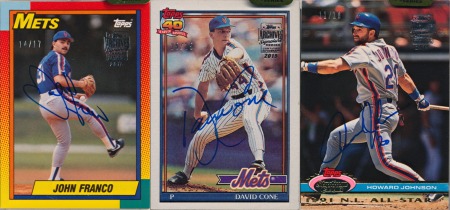 At least 17 of the 19 have cards from their Mets days. Nolan Ryan and Gary Sheffield have no Mets cards that have surfaced so far. Hall of Famers Roberto Alomar, Tom Glavine, Rickey Henderson, and Mike Piazza only have Mets cards numbered to 1. The 2006-2009 crowd, Hernandezes Livan and Orlando, Shawn Green, and Carlos Delgado have a few Mets cards each, all numbered to 31 or less. And John Olerud has about at least 10 total Mets cards (three different ones I’ve seen so far, all numbered to 2 or 4). That just leaves eight Mets, the seven usual suspects from 2004 and, of course, David Cone.
At least 17 of the 19 have cards from their Mets days. Nolan Ryan and Gary Sheffield have no Mets cards that have surfaced so far. Hall of Famers Roberto Alomar, Tom Glavine, Rickey Henderson, and Mike Piazza only have Mets cards numbered to 1. The 2006-2009 crowd, Hernandezes Livan and Orlando, Shawn Green, and Carlos Delgado have a few Mets cards each, all numbered to 31 or less. And John Olerud has about at least 10 total Mets cards (three different ones I’ve seen so far, all numbered to 2 or 4). That just leaves eight Mets, the seven usual suspects from 2004 and, of course, David Cone.
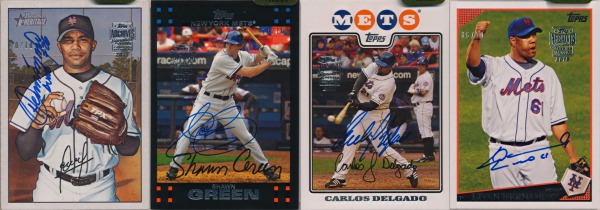 It’s a bit disappointing that those eight players account for about 95% of the approximately 3,000 total Mets autographs (and 75% of the 100+ different cards). Howard Johnson alone accounts for a quarter of the total with his 20 cards. The player diversity in 2015 Topps Archives Signature Series is largely an illusion, with just a few common signers with over a decade of autographs already available on the market accounting for virtually all of the autographs in this product. They could have simply repacked a pile of buybacks from 2004 to achieve the same result.
It’s a bit disappointing that those eight players account for about 95% of the approximately 3,000 total Mets autographs (and 75% of the 100+ different cards). Howard Johnson alone accounts for a quarter of the total with his 20 cards. The player diversity in 2015 Topps Archives Signature Series is largely an illusion, with just a few common signers with over a decade of autographs already available on the market accounting for virtually all of the autographs in this product. They could have simply repacked a pile of buybacks from 2004 to achieve the same result.
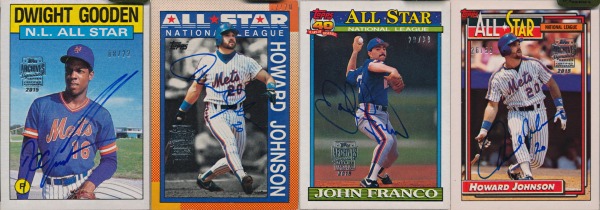 But that’s not to say that it’s a total waste. Johnson and Franco weren’t in 2004 Topps Originals, so this is a great opportunity to get base Topps buybacks to go alongside their base Donruss buybacks. And players like Delgado, Green, and the Hernandezes have few, if any, Mets autographs. Add in the variety of cards used and the fact that rookie cards have multiple copies this time around (they were numbered to 1 in 2004 Topps Originals) and you have a lot of interesting cards to chase. Best of all, most of them are dirt cheap.
But that’s not to say that it’s a total waste. Johnson and Franco weren’t in 2004 Topps Originals, so this is a great opportunity to get base Topps buybacks to go alongside their base Donruss buybacks. And players like Delgado, Green, and the Hernandezes have few, if any, Mets autographs. Add in the variety of cards used and the fact that rookie cards have multiple copies this time around (they were numbered to 1 in 2004 Topps Originals) and you have a lot of interesting cards to chase. Best of all, most of them are dirt cheap.
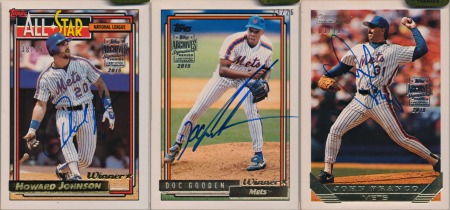 Well, that might not be so good if you’re paying $50 a pop for these cards. And it means that asking prices will probably be at least $20 once the glut of commons on the market sells through. It certainly means that a 2016 version with the same checklist should be an automatic no-go. We’ll be seeing 2015 Topps Archives Signature Series cards on the market for a long time.
Well, that might not be so good if you’re paying $50 a pop for these cards. And it means that asking prices will probably be at least $20 once the glut of commons on the market sells through. It certainly means that a 2016 version with the same checklist should be an automatic no-go. We’ll be seeing 2015 Topps Archives Signature Series cards on the market for a long time.
The Verdict
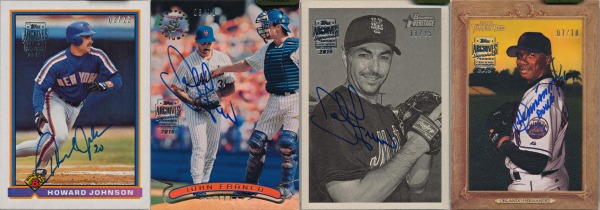 As much as I love cheap buyback autographs, I just don’t see why Topps thought this would be a good idea. Sure, it’s loaded with 1/1s from big stars, but that’s all buried under thousands and thousands of commons. And while Archives has become so focused on a very small number of designs for its autographs, Archives Signature Series goes to the opposite extreme by hitting just about every card design ever used by Topps and then some. Pull out the 1/1s and you would have a nice box topper for Archives, especially if you limit the number of designs to a select few. As a standalone product, there’s just no way something like this can be worth it.
As much as I love cheap buyback autographs, I just don’t see why Topps thought this would be a good idea. Sure, it’s loaded with 1/1s from big stars, but that’s all buried under thousands and thousands of commons. And while Archives has become so focused on a very small number of designs for its autographs, Archives Signature Series goes to the opposite extreme by hitting just about every card design ever used by Topps and then some. Pull out the 1/1s and you would have a nice box topper for Archives, especially if you limit the number of designs to a select few. As a standalone product, there’s just no way something like this can be worth it.
But on the secondary market, it sure is fun. I just wish it wasn’t more of the same.
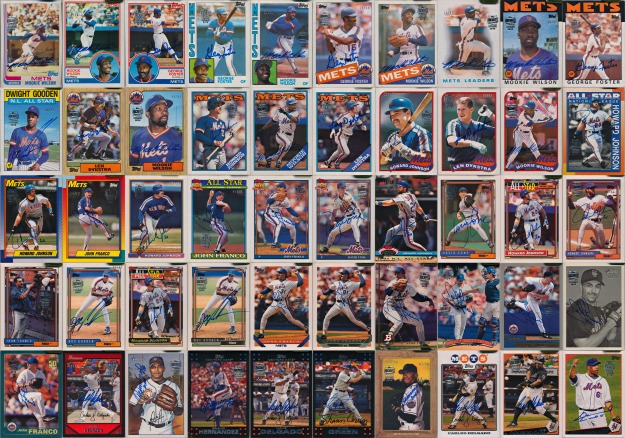
Comments are closed.